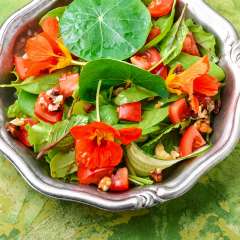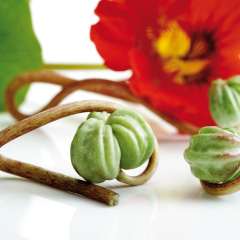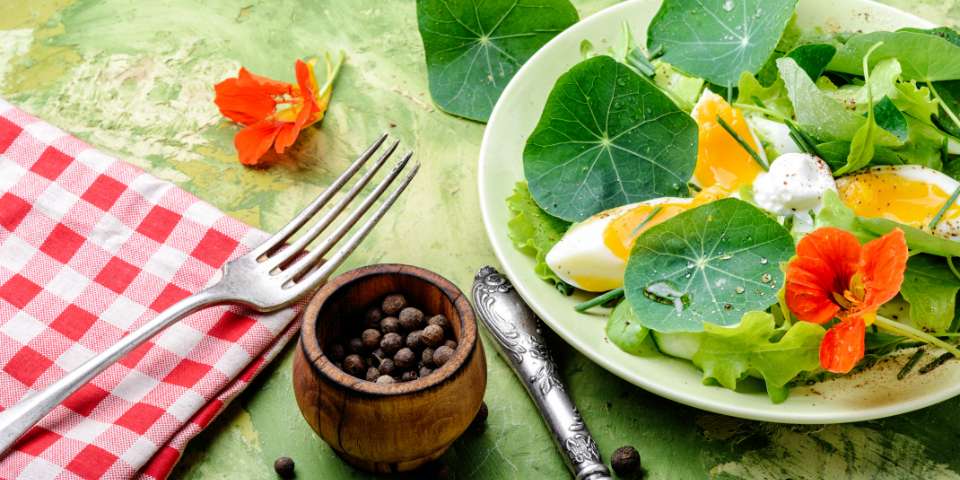This year, I’m starting a brand new raised bed garden. In planning my garden layout, I made sure to include flowers as important companions for my vegetables. One of the flowers that I plan to include is nasturtium.
Nasturtium is a tender perennial flowering herb that produces lovely blooms in shades of yellow, orange, and red. They have rounded leaves that look beautiful draping over raised beds or hanging baskets. Native to South America, they were brought to Europe in the 16th Century.Nasturtium provides many benefits, not just to my garden ecosystem, but to me and my family. I’ll discuss some of those benefits below.
Edible Nutrition
The entirety of the nasturtium plant is edible. The blooms and leaves have a peppery flavor reminiscent of mustard. Add some nasturtium blossoms to your summer salads for a bright pop of color and zing of flavor. The seeds of nasturtium can be dried and ground like peppercorns for a spicy seasoning or pickled when green to use as a substitute for capers.
Packed with Vitamins and Minerals

The leaves and flowers of the nasturtium plant contain high levels of Vitamin C (100-200% RDA in a cup of flowers) for immune system support. The leaves contain iron and other minerals. The flowers are packed with micronutrients including zinc, iron, phosphorus, potassium, calcium, magnesium, and copper.
Medicinally Useful
In addition to the wealth of nutrients, studies show that nasturtium has a multitude of uses as a natural remedy. The essential oil extracted from the flowers and leaves of the plant has antimicrobial, antifungal, hypotensive, expectorant, and anticancer effects. Because of the high levels of vitamin C, it can be used to treat digestive and respiratory illnesses. Nasturtium can also improve the condition of the skin and hair.
Helpful for Chickens
If you keep chickens, nasturtium is a great plant to have around. Nasturtium is a natural vermifuge (de-wormer) with antiseptic and other medicinal properties. Growing them around your chicken coop or adding some to your chicken’s diet will help them be healthier. You can also take advantage of the insect-repelling properties of the plant to deter insect pests.
Great Companion Plant
In the garden, nasturtium provides several benefits to surrounding plants.
Excellent Mulch

Because this plant produces an abundance of foliage, it works great as a natural ground cover that will help to hold moisture in the soil. At the end of the season, simply chop your nasturtium into the soil and all those nutrients mentioned above will be added to your soil. The dense foliage also helps keep out weeds.
Insect Pest Control
Nasturtiums have insect-repellent properties. Their peppery fragrance will help to repel insects like squash bugs, whiteflies, some beetles, and cabbage loopers. It can also function as a trap plant, attracting insects like aphids away from your precious vegetables. They are particularly beneficial when planted near brassicas like cabbage, broccoli, and cauliflower.
Attract Pollinators
The bright, trumpet-shaped blooms of the nasturtium are attractive to friendly pollinators. Because the nectar is exceptionally sweet and the flowers are large and in the yellow-red color spectrum, nasturtiums are especially attractive to hummingbirds. Smaller pollinators like bees also enjoy the nectar.
Easy to Grow

Nasturtium is very easy to grow. It is not picky about soil conditions and will grow well in full sun, or partial shade. It grows well in the garden or containers.
Sow nasturtium seeds outside after the last frost, or start them indoors a few weeks earlier in peat pots that can be directly transplanted into the garden. Nasturtium roots do not like to be disturbed, so starting in a typical seed tray may not be successful. You may have more success with germination if you soak the seeds or scarify them by rubbing lightly on some sandpaper before sowing.
Choose a spot with full sun if you want to maximize blooms, however, they will grow well in partial shade as long as they get 3 to 6 hours of sunlight per day. Keep the soil moist, but not wet throughout the growing season. Nasturtiums are somewhat drought tolerant but prefer moist soil. Thin seedlings to 8 to 12 inches apart. Nasturtiums do well in poor soil and do not usually need additional fertilizer. Too much nitrogen will discourage blooms.
This plant’s bounty of blooms means a plethora of seeds. Nasturtium will self-seed easily, or you can collect the large chickpea-sized seeds as they fall from the plant. The seeds may be green when you collect them. Allow them to dry thoroughly until they turn brown and keep in a cool, dry place for planting next season.
Beautiful
In the end, one of the primary reasons I will include nasturtiums in my garden is the fact that they are simply beautiful. Nasturtium grows very quickly and blooms for most of the year until it’s hit by frost. To further encourage blooms, be sure to deadhead expired blooms.
I encourage you to add nasturtiums to your vegetable garden this year. In addition to their vibrant colors and unique peppery flavor, nasturtiums offer an array of benefits to your vegetable garden. Not only do they attract pollinators and deter pests, but their fast-growing nature also helps suppress weeds. So, the next time you are planning your garden layout, include some nasturtiums – your taste buds and your veggie patch will thank you for it!
Written by: Jennifer C. Hudson Valley, NY Zone 6b

























